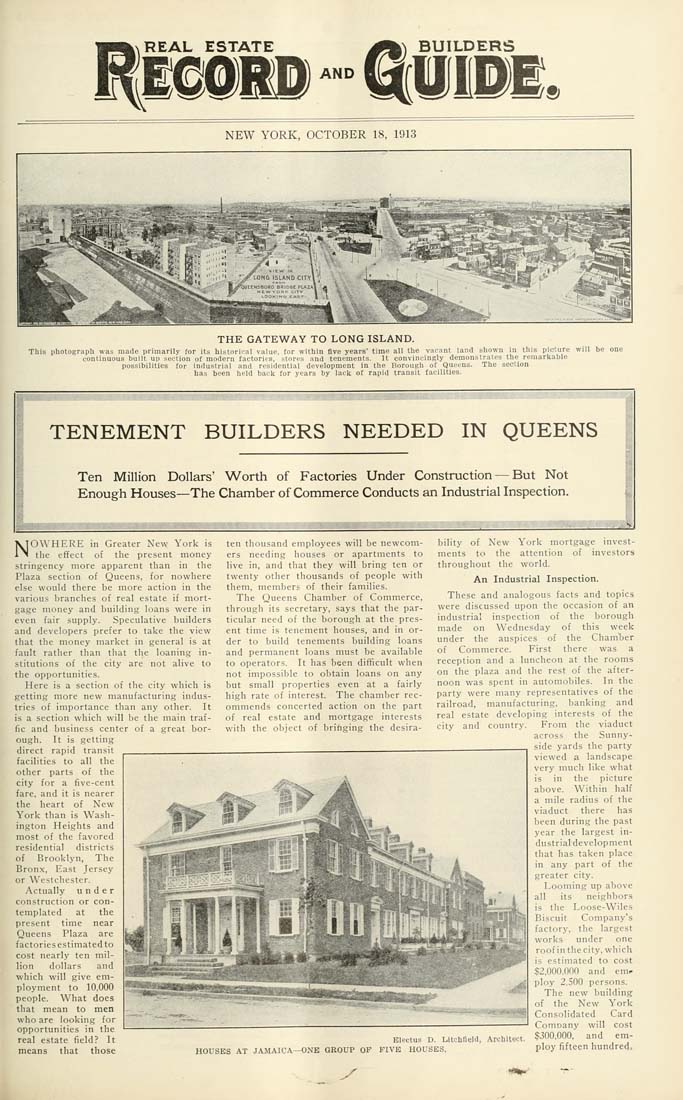Columbia University Libraries Digital Collections: The Real Estate Record
Use your browser's Print function to print these pages.
Real estate record and builders' guide: [v. 92, no. 2379]: October 18, 1913

Text version:
Please note: this text may be incomplete. For more information about this OCR, view About OCR text.
REAL ESTATE AND b^ BUILDERS NEW YORK, OCTOBER 18, 1013 THE GATEWAY TO LONG ISLAND. This photograph was made primarily for its historical value, tor within flve years' time all the vacant land shown in this picture will be one continuous built up section of modern factories, stores and tenements. It convincingly demonstrates the remarkable possibilities for industrial and residential development in the Borough of Queens. The section has been held back for years by lack ot rapid transit facilities. lillllillilllllillillllllililllllll I TENEMENT BUILDERS NEEDED IN QUEENS Ten Million Dollars' Worth of Factories Under Construction — But Not Enough Houses—The Chamber of Commerce Conducts an Industrial Inspection. i ■■■■■IlilMili III ■III IIIIIIIIIIIIIIIIIIIPII! lil NOWHERE in Greater New York is the effect of the present money stringency more apparent than in the Plaza section of Queens, for nowhere else would there be more action in the various branches of real estate if mort¬ gage money and building loans were in even fair supply. Speculative builders and developers prefer to take the view that the money market in general is at fault rather than that the loaning in¬ stitutions of the city are not alive to the opportunities. Here is a section of the city which is getting more new manufacturing indus¬ tries of importance than any other. It is a section which will be the main traf¬ fic and business center of a great bor¬ ough. It is getting direct rapid transit facilities to all the other parts of the city for a five-cent fare, and it is nearer the heart of New York than is Wash¬ ington Hei,ghts and most of the favored residential districts of Brooklyn, The Bronx, East Jersey or Westchester. Actually under construction or con¬ templated at the present time near Queens Plaza are factories estimated to cost nearly ten mil¬ lion dollars and which will give em¬ ployment to 10,000 people. What does that mean to men who are looking for opportunities in the real estate field? It means that those ten thousand employees will be newcom¬ ers needing houses or apartments to live in, and that they will bring ten or twenty other thousands of people with them, members of their families. The Queens Chamber of Commerce, through its secretary, says that the par¬ ticular need of the borough at the pres¬ ent time is tenement houses, and in or¬ der to build tenements building loans and permanent loans must be available to operators. It has been difficult when not impossible to obtain loans on any but small properties even at a fairly high rate of interest. The chamber rec¬ ommends concerted action on the part of real estate and mortgage interests with the object of bringing the desira- Electus D. Litchfleld, Architect. HOUSES AT JAMAICA—ONE GROUP OF FIVE HOUSES, bility of New York mortgage invest¬ ments to the attention of investors throughout the world. An Industrial Inspection. These and analogous facts and topics were discussed upon the occasion of an industrial inspection of the borough made on Wednesday of this week under the auspices of the Cham'ber of Commerce. First there was a reception and a luncheon at the rooms on the plaza and the rest of the after¬ noon was spent in automobiles. In the party were many representatives of the railroad, manufacturing, banking and real estate developing interests of the city and country. From the viaduct across the Sunny¬ side yards the party viewed a landscape very much like what is in the picture above. Within half a mile radius of the viaduct there has been during the past year the largest in¬ dustrial development that has taken place in any part of the greater city. Looming up above all its neighbors is the Loose-Wiles Biscuit Company's factory, the largest works under one roof in the city, which is estimated to cost $2,000,000 and em^ ploy 2.500 persons. The new building of the New York Consolidated Card Comnany will cost $300,000, and em¬ ploy fifteen hundred, ^ mi^'